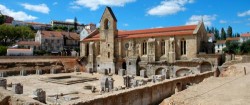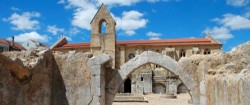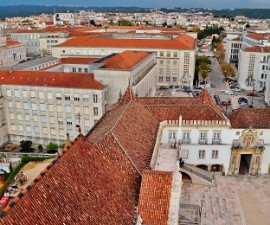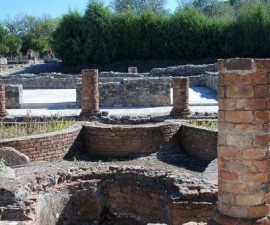The Santa Clara-a-Velha Monastery is a Gothic building located in the heart of the city centre in Coimbra, Portugal. Built in the 14th century, it occupies a prime position on the banks of the Mondego River that runs through the city.
Abandoned in the 1600s due to persistent flooding from the river, the monastery was more or less forgotten until it was excavated some 300 years later. Some 12 years of restoration works by some of the Portugal’s most talented architects, archaeologists, artists and stone masons has seen it reopened and it is now a popular stop on the sightseeing train for most visitors who choose to spend time in the delightful historic city of Coimbra, Portugal.
The Santa Clara-a-Velha Monastery was originally founded by Mor Dias as an order for the poor, and was backed by Queen Elizabeth, wife of King Dinis I, whose palace ruins are located near the monastery. The Queen was in fact buried in the monastery following her death in 1336.
The architect Domingos Domingues was employed to carry out the design and building works subsequent to his work on the Monastery of Alcobaça, another Portuguese historical landmark, and his work was continued by Estevao Domingues, who also worked on the cloisters of the Lisbon Cathedral.
After persistent flooding due to the monastery’s positioning — too low on the banks of the river — it was finally declared too unsafe and abandoned by the nuns in favour of a new monastery, the Monastery of Santa Clara-a-Nova, on a nearby hill.
300 years of decay followed before its historical importance was recognised and the remains were declared a National Monument in 1910 and some initial renovations were carried out.
It was shortly before the turn of the century, however, before a major campaign was launched in Coimbra to restore the Santa Clara-a-Velha Monastery to its former glory. To the project leaders’ delight, they found that the water and mud that had encased the ruins had in fact preserved them remarkably well, allowing them to uncover many architectural and decorative pieces.
The remains of the building can be seen via tours through its footprint and its adjoining visitor centre, which houses a collection of recovered artefacts and provides plenty of information about its architecture and historical importance, and the on-going project of renovation and discovery.
Visitors who have previously seen the Monastery of Alcobaça will note many similarities between the two buildings, with their three-aisled nave and stone vaulting, which was a departure from the norm in Portugal’s ecclesiastical style of the time.
Much of the building remains largely intact, such as the columned cloisters with their decorated capitals depicting vegetable motifs, and an attractive Gothic fountain is also found here. Other areas are in much greater state of ruin but none the less interesting in their own right, such as the chapter house, lunchroom, and Queen Elisabeth’s Palace, whose foundations can all be viewed on the site.





